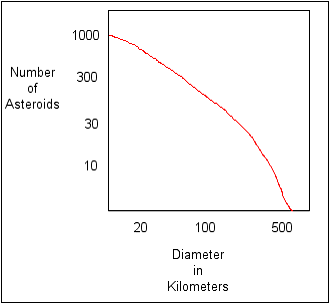Asteroids
 The majority of asteroids are rocky planetoids orbiting the Sun between the orbits of
Mars and Jupiter. This region is known as the Asteroid Belt. There are also groups of
asteroids both 60 degrees ahead and 60 degrees behind Jupiter in its orbit. These are called Jupiter
Trojan Asteroids. Another two groups ahead and behind Mars are called Martian Trojans.
Asteroids have been found elsewhere in the solar system, including inside Earth's
orbit of the Sun. Some, like
Cruithne, have very odd orbits.
The majority of asteroids are rocky planetoids orbiting the Sun between the orbits of
Mars and Jupiter. This region is known as the Asteroid Belt. There are also groups of
asteroids both 60 degrees ahead and 60 degrees behind Jupiter in its orbit. These are called Jupiter
Trojan Asteroids. Another two groups ahead and behind Mars are called Martian Trojans.
Asteroids have been found elsewhere in the solar system, including inside Earth's
orbit of the Sun. Some, like
Cruithne, have very odd orbits.
Most asteroids are the size of gravel but 16 asteroids have a diameter of 240 km or more. Ceres is the largest asteroid. It has a diameter of about about 914 km which is roughly the size of Texas. Since the orbital radius of the average asteroid in the asteroid belt closely satisfies the prediction of the Bode Titius Rule, it seems reasonable (at first) to speculate about asteroids in terms of a "failed planet." In view of this hypothesis, consider the following observations.  This graph shows the number of discovered asteroids and their size.
The data are more complete for the larger objects because they are easier to see in telescopes.
This graph shows the number of discovered asteroids and their size.
The data are more complete for the larger objects because they are easier to see in telescopes.
Ceres, the largest of all the asteroids, was first found by the Italian astronomer Giuseppe Piazzi who discovered it by chance in 1801. It was in fact the first asteroid ever discovered. The diameter of Ceres is about 1000 km. The diameter of Mars is a little less than 7000 km. Although neither is a perfect sphere (especially Ceres), use the volume of a sphere (4/3 pr3) to estimate how many Ceres-sized asteroids would fit into a volume the size of Mars: 343 Here is a table that shows the number of asteroids in groups according to size, and the total volume of material in each group.
Add up the values in the last column to estimate the total volume of material that is contained within the asteroid belt: 4.87 x 108 km3 The volume of the Earth is roughly 1.0 x 1012 km3. What approximate percentage of the Earth's volume does the sum of all the asteroid volume represent? 0.0487%, an extremely small fraction of the volume of the Earth!
|
|||||||||||||||||||||||||||||||||||||||||||||||||||||||||||||||||||||||||||||||||||||||||||||||||||||||||||||||||||||||||||||||||||||||||||||||||||||||||||||||||||||||||||||